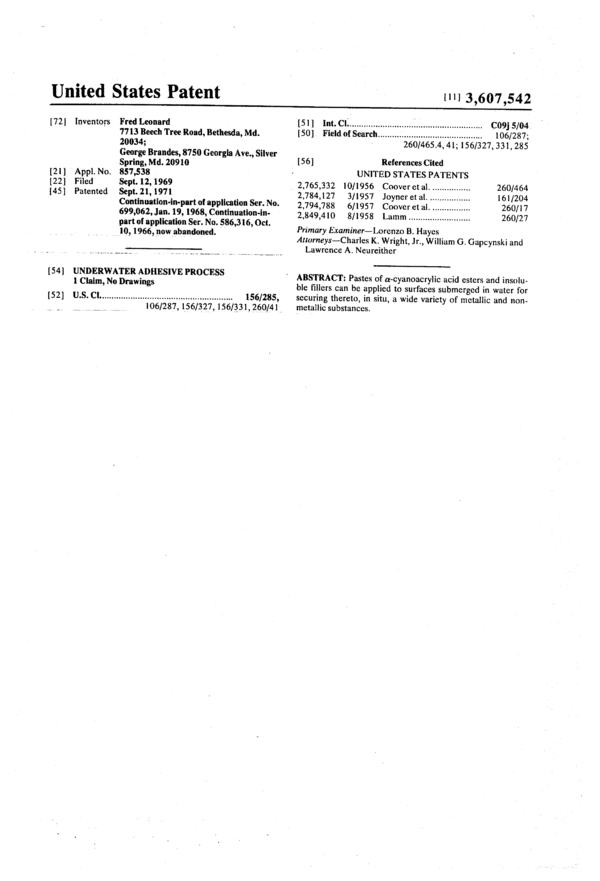Underwater Adhesive Process
Underwater Adhesive Process
US3607542
Year:
Abstract:
Pastes of alpha-cyanoacrylic acid esters and insolluble fillers can be applied to surfaces submerged in water for securing thereto, in situ, a wide variety of metallic and non. metallic substances.
Type of document:
Language:
3,607,542
5
6
Monomer'
a~cyano-
Filler l
Paste
gramsFlow
Example
acrylate
I'
oetyl
CaCO,
2'
heptyl
fair
SiO. 0.3
CaCO, 2.7 excellent
heptyl
3.4
heptyl
CaCO, 2.6
sio, 0.1 to
0.2
CaCO, 3.4
heptyl
CaCO, 2.7
hexyl
CaC0.:s
amyl
CaCO,
3.5 fair
butyl
CaCO,
201'
110'
187'
100'
175'
25t1'
2.5 good
2.0 very thin
nonyl
l'
Surfaces··
Average
Bond
Strength in
Tension
(p .s. i.)
8'
CaC0.:s 2.7
SiO, 0.05
CaCO, 2.7
Si0 2
0.05
CaCO, 2.7
0.05
SiO,
CaCO, 2.7
10
475"
410'
609'
710 11
rubber/steel 74'
rubber/wood 3 If
glasS/glass
7'
5
15
d
225'
135'
112'
253'
80'
150'
420'
20
and fluid
10
deeyl
II
cyclohexyl
12
ethoxy-
210
885
270
ethyl
13
isobutyl
14
isopropyl
15
2-ethyl-
SiO,
CaCO,
SiO,
CaCO,
SiD,
CaCO,
0.1
2.7
0.05
2.7
0.05
2.7
30
260
360
310
hcxyl
16
propyl'
17
ethyl'
18
methyl"
19
hexyl
20
2-ethyl-
0.05
SiD"
CaCO, 2.6
sio, 0.1
CaCO, 2.7
0.1
Si0 1
CaCO, 2.7
sio, 0.1
BaCO, 2.7
0.1
SiO!
CaSO. 2H,0 2.0
25
200
35
200
75
75
40
750
210
hexyl
21
butyl
22
allyl
n-hcxyl and
n-arn yl
24
trifluoroisopropyl
0.1
SiDI
CaSO, I>H,O 3.0
5i0 2
0.1
CaCO, 2.7
SiD,
0.1
BaCO, 2.7
400
SiO, 0.1
CaC0 3
2.7
155
SiD,!
80
45
250
50
0.1
**AII examples adhere two stainless steel surfuces under fresh water. unless
otherwise specified.
'"Salt water used in this sample.
'I Immediate sealing.
r. Sealing after a J -minute immersion.
I' Sealing after a 2-minute immersion.
" G lass slides broke. precluding reading,
,. Bond strengths as high as 580 p.s.i. obtained in individual tests.
r Peel strength; rubber peeled from steel and wood substrates.
" Held together for only I minute under water.
hexyl-o-cyanoarcylate (pH 3.7), 3.6 parts by weight of calcium carbonate and 0.2 part by weight of "Cab-O-Sil," additional bonds are prepared under water as set forth in examples
25 to 32. In these examples all test specimens (except those
with corroded or painted surfaces) are prepared for adhesive
bonding by vapor degreasing for 5 minutes with
trichloroethylene. This is followed by a hoI water rinse and
then a final wash in methyl ethyl ketone.
The procedure for each test (run) in examples 25 to 32 is as
follows:
a. Water in a container is regulated at the indicated temperature;
b. Test specimens are submerged in the water;
c. Adhesive is applied to bonding surfaee of one submerged
test specimen;
d. Adhesive is spread over entire bonding area by sliding
test specimens over one another;
e. Moderate hand pressure (approximately I pound) is applied between bonding surfaces for a time interval A;
f. Bonded test specimens removed from water and placed in
Dillon Dynamometer for pull tests;
g. Load applied between test specimens; time interval B is
the interval between conclusion of time interval A and
application of load.
The adhesive cure begins immediately upon contaet with
water. Up to 2 minutes are available following application to
spread the adhesive and bring the bonding surfaces together.
All ingredients are stored in closed containers. The hcxyl-ocyanoacrylate is packaged in a polyethylene bottle. Cardboard
cans are used to package the amorphous silica and the calcium
carbonate.
The mixed adhesive paste can be readily applied from its
collapsible squeeze tube container for a period up to 4 hours.
The following portions of Federal Test Standard 175, Adhesive Methods of Testing, are used for performing the physical
tests:
Method 1011.1 - Tensile Properties of Adhesives
Method 1033.1-T - Shear Strength Properties of Adhesives
by Tensile Loading.
All tests for each example are performed on the same day
with the same adhesive batch. The bond area for each test is
one square inch. 7.8 grams of mixed adhesive composition is
adequate for approximately 20 thin film tests.
The aluminum alloy employed in each of examples 25
through 32 is aluminum alloy AA6061-T6 anodized per
Mil-A-625 and having a surface roughness of 32, In each of
said examples the steel is steel per Mil-S-16216, Grade
HY-80; in examples 25, 28, 29, 31 and 32 the surface
roughness is 32; in examples 26 and 30 the surface bonded is
badly oxidized to a finish of approximately 125; in example 27
the surface bonded is painted per NAYORD USTD 52,
System No. 48 (antifouling).
55
EXAMPLE 25
Steel is adhered to anodized aluminum alloy submerged in a
3 percent solution of salt (NaCl) water having a temperature
60 of 70° F. Ten repetitions produce the following results:
h Paste delivered as a glob through a polyethylene tube to one of the two steel
surfaces held under water.
i
All silica (5iO,) used in the examples in conjunction with the filler is
amorphous silica.
j In each example 3.0 grams of monomer are used, except in Example 1 where
6.1 grams of monomer are used; in Example 23,1.5 grams of each monomer are
ernptoyed. Eaeh"!~J isE~~f!l~s~?.tJ1~r~is~.~.!'£ifi~d,•..._ ..•_
.
65
A'
B"
45
37
Heptyl-a-cyanoacrylate admixed with calcium carbonate
45
75
(CaC03 ) and amorphous silica (as in the examples) was also
45
48
found to form strong bonds (under water) of aluminum to alud
45
81
minum. In the same manner wood/wood and rubber/rubber 70
45
55
44
45
bonds were formed. Although there may be some variation in
J
45
57
K
maximum tensile or shear strengths and the optimum pH may
h
45
42
differ, strong bonds are likewise formed under water for
45
62
glass/glass, plastic/plastic (phenol/formaldehyde thermoset 75
47
45
plastic) and combinations of the noted substrates, e.g.
~topl/~h1fT1i"l1m nl~~ti£"l,:"b~~ ~nn'W()O:{\(f1~inted 'steel,
.. Tim" I., ""f·ntHI,!, In of/man: seccirnen bond H
Tensile Strengths
[p.s.i.}
90
375
190
325
425
275
450
125
475
Average 61.5
Time in seconds (unlc,,'( otherwise
Coments go here:
- Log in to post comments

